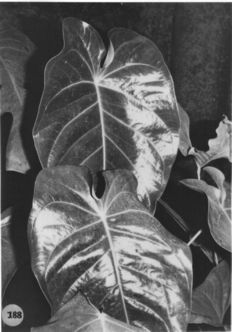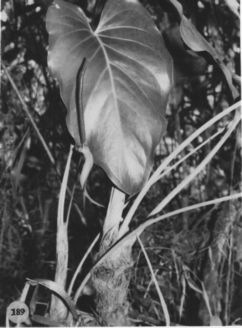





Brenesia 16 (Supl. I): 88. 1979. TYPE: Costa Rica. San José: ca. 5 miles SW of Canaan along gravel road from Rivas; steep slopes, ca. 900 m elev. 14 August 1977, Croat 43439 (MO-2582987, holotype; CR, F, K, NY, PMA, SEL, US, VEN, isotypes; Live at MO).
LEAVES with petioles erect to spreading, 43-120 cm long, 7-16 mm diam., terete; geniculum 2-4.5 cm long; blades ovate, moderately thin, obtuse to usually short-acuminate at apex, lobed at base, 40-75 cm long, 25-56 cm wide, broadest at point of petiole attachment or slightly above; anterior lobe 33-55 cm long, the margins broadly convex; posterior lobes 8-21 cm long; sinus spathulate to obovate, often overlapping, the inner edges fumed up, acute at apex; upper surface semiglossy to glossy, lower surface semiglossy; midrib triangularly raised above, diminishing toward apex, convexly raised below; basal veins 4-6 pairs, 4 or 5 of them coalesced 1-4 cm, raised above and below; posterior rib slightly curved, naked, the outer margin sharp and often rolled up; primary lateral veins 5-9 per side, departing midrib at 45°-65° angle, straight then arcuate-ascending, usually only the uppermost loop-connecting, convexly raised above and below; interprimary veins obscure or occasionally raised in valleys above, raised below; secondary veins slightly sunken in posterior lobes above, flat and slightly darker than surface below; collective vein arising from one of the primary lateral veins in the upper half of the leaf, 4-11 mm from margin, slightly sunken above, raised below.
INFLORESCENCE erect to spreading, much shorter than the leaves; peduncle 29-76 cm long, 4-9 mm diam., terete; spathe moderately thick, green (B & K Yellow-green 6/7.5), oblong-lanceolate, 10.5-18 cm long, 2-4 cm wide, broadest ca. 1 cm above point of attachment, narrowly acuminate at apex, obtuse to rounded at base, inserted at 60° angle on peduncle; stipe 11-70 mm long in front, 6-60 mm long in back, ca. 5 mm wide, medium green; spadix green before anthesis, soon heavily tinged with violet-purple, turning yellowish-brown, 10-30 cm long, 7-10 mm diam. at base, 4-6 mm diam. at apex; flowers rhombic to weakly 4-lobed, 3.5-3.6 mm long, 2.9-3.3 mm wide, the sides nearly straight parallel to spirals, smoothly sigmoid perpendicular to spirals; 5-7 flowers visible in the principal spiral, 5-10 flowers visible in the alternate spiral; tepals semiglossy, smooth, with numerous nectar droplets, lateral tepals 1.9-2 mm wide, the inner margin broadly rounded; pistil weakly raised, medium green; the stigma linear, 0.4-0.7 mm long, a slight slit briefly filling with nectar a few days before first stamens appear, dry and slightly darkened when stamens emerge; stamens beginning to emerge from or near the base, all 4 stamens in a spiral opening soon after the first, held in a close circle around pistil, obscuring pistil; anthers orange to greenish-yellow, 0.6-1 mm long, ca. 1 mm wide; thecae cllipsoid; pollen orange, fading creamy white.
INFRUCTESCENCE arching; spathe reflexed; spadix to 30 cm long, 2 cm wide; berries broadly ovoid, rounded at apex, orange; mesocarp pulpy, bitter lasting; seeds 2, white, to 5 mm long. Figs. 188 and 189.
The species is in section Pachyneurium and is known for certain only from Costa Rica in the Cordillera de Talamanca. It was first collected by Paul Standley at two sites. La Verbena and San Sebastian south of San José, in what is probably premontane wet forest. It has been collected more recently in the region northeast of San Isidro del General. The species ranges from 900 to 1,900 m elevation and may be restricted to premontane wet forest.
A cultivated collection from the University of Hawaii was reportedly
based on a Dressier collection from Achiote, a region of tropical moist
forest in the Isthmus of Panama. The species has never been collected in
Panama to our knowledge, and the collection cultivated in Hawaii is probably
mislabelled.
 |
 |
Map of Mesoamerican specimens with coordinates
Costa Rica Puntarenas: Río Coto Brus,, 9 Aug 1974, Thomas B.
Croat 26674 (MO).
Costa Rica Puntarenas: Las Cruces Botanical Garden, 1300 m,, 11 Jan
1978, Thomas B. Croat 44436 (MO).
Costa Rica San José: 1150 m, 09.54.30N 84.13.00W, 21 March 1989, Michael
Grayum, Pam Sleeper & Nadja Chamberlain 9329 (MO).
Costa Rica San José: 1150 m, 09.55.00N 84.08.30W, 4 June 1989, Michael
Grayum 951